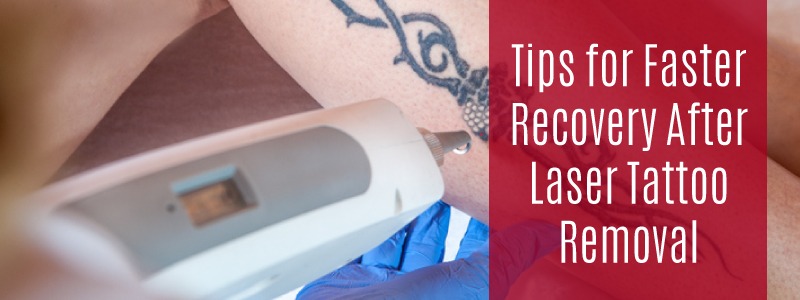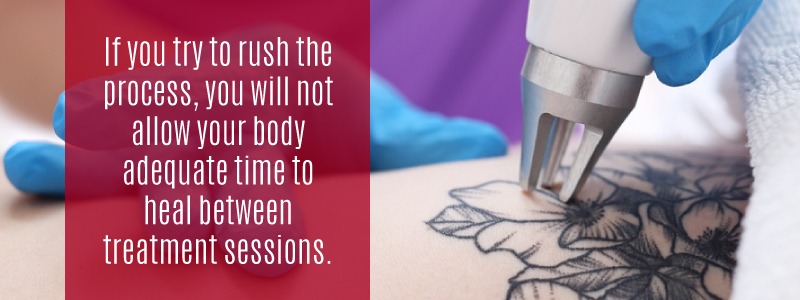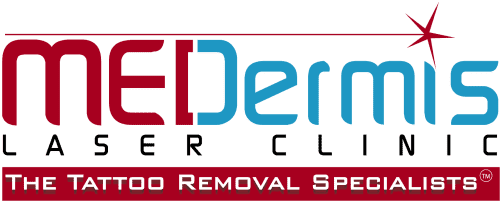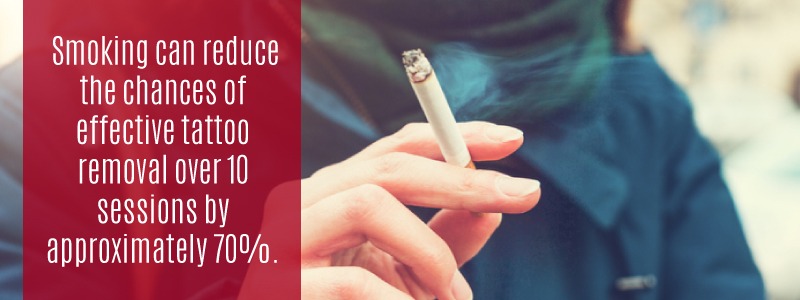
Tips for Faster Recovery After Laser Tattoo Removal
Reduce tattoo removal scars and pain with these tips from MEDermis.
Tattoos are a wonderful way to express yourself. This form of body art is so popular that 45 million Americans have some kind of tattoo, but they are a lifetime commitment. One study found approximately 23 percent of people who get tattoos regret the decision.
Why do people change their minds?
- The tattoo might no longer hold the same emotional significance it did when you first got it.
- Maybe the quality of the artwork is not what you expected, or perhaps the quality did not age well.
- You could feel your personality or circumstances have changed, and the tattoo no longer reflects who you are.
- Although taboos around tattoos are changing, you might be concerned about how the ink might affect your professional life.
Whatever the reason you are no longer happy with your tattoo, you do not have to live the rest of your life with it on your skin. A successful tattoo removal is a viable option. Read our ultimate guide to tattoo removal.
In the past, tattoo removal involved physically scraping away the ink, which unsurprisingly damaged the skin, but now we have far more sophisticated tattoo removal methods.
The current standard for tattoo removal is laser treatment. The most common type of laser treatment uses equipment called the Q-switched laser, which pulses light rapidly to dissolve the tattoo pigments without serious side effects.
Tattoo removal sessions typically last between 15 and 30 minutes. How many sessions it takes to remove a tattoo varies on its size, location and coloration, but generally, three to seven sessions scheduled a month and a half to two months apart will ensure complete removal of a tattoo.
While laser tattoo removal treatment has minimal risks, it is important to know proper tattoo removal aftercare.
Here are some helpful tips for making the laser tattoo removal recovery process faster and more effective, and to help reduce pain and scarring.
The Laser Tattoo Removal Aftercare Process
To heal properly and avoid infection it’s crucial that you follow a strict aftercare regimen. Not only will doing so help speed up the healing process, but it can make all the difference in protecting your skin in the long run.
What to Expect from Day 1 to Weeks After Tattoo Removal
To give you a better idea of how to follow the aftercare routine we think it will be helpful to have an understanding of what to expect from your skin throughout the removal process. Here’s a rough timeline:
- Immediately after treatment. The treated area will typically turn to a frosty white; caused by the release of carbon dioxide as the laser penetrates the skin and it’s totally normal.
- 8-72 hours after treatment. The treated area begins to peel or blister. Scabs and crust may also develop during this time.
- 1-2 weeks after treatment. Healing time will vary depending on the location of the tattoo, but all blistering, scabs and other signs of irritation should fully subside.
- 4-6 weeks after treatment. The treated area should be fully healed, and you’re ready for the next session (if necessary).
During this timeline, you will most likely experience:
- Discomfort. The laser tattoo removal process will not be painless. However, with our extensive experience, we have developed a unique numbing technique that prepares the upper layers of skin. This method is very safe and is localized to the treated area only.By going through the process ourselves, that’s how we figured out this numbing technique. With the experience and training that we have, we will make each treatment as comfortable and quick as possible.After treatment, you may experience a few uncomfortable laser tattoo removal side effects such as redness, blistering, swelling, scabbing, itching and small amounts of bleeding.
These minor symptoms will likely only last a few days after each treatment.
In the interim, you can soothe the discomfort with an ice pack. You may notice the blisters will lead to skin peeling that can last up to two weeks after a laser treatment session.
You’ll need to wait 6-8 weeks between each session to allow your body to dispose of the tattoo ink the laser has dissolved. This time frame will be determined when we are checking you out and scheduling your follow up appointment.
- Skin Discoloration. During the laser tattoo removal healing process, you will likely notice some temporary skin discoloration. As the laser breaks up the ink, the upper layer of your skin will likely turn a shade of white. This side effect is known as frosting and will change as the skin peels off during the recovery process between treatment sessions. Hyperpigmentation and hypopigmentation are other potential side effects to keep in mind.
Hyperpigmentation is a darkening of the skin. The laser’s pulses of light waves can affect the natural color of your skin. People with darker skin tones are more likely to experience hyperpigmentation.
Hypopigmentation is a lightening of the skin’s natural color, a side effect more common in people with lighter skin tones.
In most cases, the skin will return to its natural color within six months to a year following your final treatment, but it is possible for hyperpigmentation and hypopigmentation to be permanent.
- Expectations. During the recovery and healing process, it is important to manage your expectations. Laser tattoo removal is an effective treatment, but the results are sometimes not perfect. The type of ink in your tattoo, its size and its location can mean varying results.For example, black color on lighter skin is typically very easy to remove. On the other hand, green and purple ink can be very difficult to remove from any skin tone. Larger tattoos will take longer to remove, and the larger surface area may make it more difficult to remove the tattoo completely.
You should also know tattoos located farther down on your arms and legs may be more difficult to remove completely. The farther away from your heart, the poorer the circulation.
Tattoos removed from areas like the ankle may also take longer to recover due to circulation issues. Your tattoo will be gone or nearly gone after you complete your sessions, but keep in mind results will vary.
Tips for Speeding up the Healing Process
Proper laser tattoo removal aftercare will help ensure you have a smooth and quick recovery.
- Prep your immune system. Your immune system plays a vital role in any sort of recovery process, and the same is true of laser tattoo removal recovery. In preparation for your treatment sessions, focus on eating nutritious foods and exercising. Adding those two things to your routine will help keep your body healthy and ready to help you heal. Try immune-boosting foods like citrus fruits, which have lots of vitamin C, or ginger, which has anti-inflammatory properties.

- Proper cleaning. Proper cleaning of the treated area goes a long way toward preventing infection, which is a big stumbling block on the road to recovery. Each day, clean the area with cool water and pat it dry. Avoid rubbing the area, as this can further irritate the tender skin. You should also apply an antibiotic ointment to the area, particularly any blisters that have burst, and cover it with a clean bandage during the first three days after a treatment session to provides further protection against potential infection.
- Topicals. Once you have gotten past the three-day mark, you can use a variety of different topicals to help achieve faster recovery from laser tattoo removal. Vitamin E oil or hydrocortisone cream can help you manage irritating symptoms like itching. If you give in to the temptation to scratch, you can prolong skin irritation and increase the likelihood of scarring. Soothing topicals can help prevent scarring from laser tattoo removal. It is also important to remember to wear sunscreen on the area for up to three months after your final session. Remember, wearing sunblock during any prolonged period in the sun is a good habit to form.
- Cool compresses. Swelling and redness are common side effects of laser tattoo removal. If you are experiencing inflammation, it can be tempting to touch or pick at the affected area. Instead, use a cool compress to help reduce inflammation, which can be particularly helpful for the first day following a treatment session. You can use things like a cool, damp cloth, an ice pack or a bag of frozen vegetables from your freezer. After you are done using the cool compress of your choice, remember to properly clean and dry the area.
- Avoid unnecessary stress. Stress can severely impact our ability to heal. While you are recovering, try to stay calm and level-headed. You can go about your daily life, but do your best to avoid overly stressful situations. Maybe you can even treat yourself to some great relaxation techniques like a long walk or a massage. Whatever stress relief and management techniques you like best, this recovery period is a great time to use them.
- Consider taking a break from smoking. It is no secret smoking is an unhealthy habit, but it can affect your body in surprising ways. Smoking can reduce the chances of effective tattoo removal over 10 sessions by approximately 70 percent. Smoking causes your blood vessels to constrict, but you need good, strong circulation for your body to clear the pigments from the tattoo effectively. If you do smoke, try to stop or reduce consumption during your treatment period to maximize the effectiveness of the treatment.
- Take a break from exercise. Whether you’re going to spin class, lifting weights, or chasing your kids at the park, you want to be mindful of your body during treatment. We recommend taking a break from any activity that may cause or increase swelling. Typically, clients with smaller tattoos can get back to their regular exercise routine within a day after treatment, while those with larger tattoos should consider waiting at least 48 hours. We also recommend showering and changing the dressing on your affected area after strenuous activity.
- Skip happy hour. Consuming large amounts of alcohol can impact your liver and kidneys’ ability to flush out the tiny ink particles created during laser removal. While undergoing treatment, we recommend swapping out alcoholic drinks for more water to aid your body in the healing process and help the removal go more smoothly.
Things to Avoid During the Healing Process
What you do not do can be just as important as what you do throughout the healing process.
Six things to avoid after tattoo removal for a speedy recovery:
- Soaking in water or swimming. It is fine to shower within a few hours of a treatment session but be careful to avoid high-pressure spray on the treated area. You will also want to avoid soaking the affected area while you have any blisters or scabs. Exposing your skin to the water in a bathtub, swimming pool or hot tub puts you at risk for an infection, which will significantly slow the recovery process. Avoiding these could help minimize your risk of infection. Getting wet is not a big deal, but if you do go in any of the water sources mentioned above rinse thoroughly with clean water and mild soap (no scrubbing) and apply ointment and bandages.
- Shaving. You might have to put up with a little stubble during the healing process. Shaving the affected area can lead to irritation or nicks in the skin, which make an infection more likely. Similarly, you should avoid machine epilation hair removal for at least six weeks before your treatment sessions. Like shaving, this hair removal process can irritate your skin and open the door for infection.
- Stay Out of the Sun. Your laser specialist will say this over and over again—avoid the sun! Sun exposure during treatment can be unsafe and may even lead to the denial of treatment. If you get a sunburn during your process we will need to delay your sessions which will drag the process on for a longer time. If you must be in the sun while undergoing laser removal take precautions by using sunscreen and covering your affected area with bandages and clothing.
- Tanning products. It’s best to avoid tanning products during the entire laser tattoo removal process. Your skin will absorb the chemicals in tanning lotion or tanning spray, which can affect the treatment process. Tanning products also increase the risk of several side effects, including hyperpigmentation and blistering. Skip the tanning bed and sunbathing, too. Prolonged exposure to UV rays can make your skin sensitive and more prone to burns. Plus, sunshine increases your body’s vitamin D levels, which can affect the efficacy of the laser treatment.
- Picking any scabs. If you want to prevent scars from laser tattoo removal, do not pick at the scabs that may form after each treatment season. Itching can make it tempting to pick at the scabbed skin, but this can increase your risk of infection and slow the healing process. Allow the scab to fall off naturally. You should also try to be careful not to rub up against anything that will remove the scab. Wear loose, comfortable clothing, and protect the sensitive skin with a clean bandage for the first few days after your laser treatment session.
- Taking antibiotics. Antibiotics can cause skin sensitivity in some people, which is best to avoid during laser tattoo removal sessions. If you need to take a round of antibiotics, consider putting off your tattoo removal until the medication is out of your system. If you need to take a round of antibiotics in the middle of your laser treatment sessions, talk to your tattoo removal technician beforehand.
- Rushing time between appointments. Once you have decided to have a tattoo removed, you probably want it to happen as quickly as possible. However, remember this is a gradual process when you are scheduling your appointments. If you try to rush the process, you will not allow your body adequate time to heal between treatment sessions, which means you may experience more side effects. Talk to your removal technician and take their advice on scheduling your next appointment.
What to Do If You Experience Side Effects During the Healing Process
- Over-the-counter pain relievers. You will probably experience some level of discomfort after each laser tattoo removal session, which is perfectly normal. Depending on your pain tolerance, you might not need to do anything other than ignore the discomfort. If you find it to be too much or just distracting, you can take over-the-counter pain medications such as Tylenol to help. You should skip the aspirin, though, because this medication acts as a blood thinner, which can put you at higher risk for bleeding and bruising at the treatment site.
- Vitamin E oil. Many people are concerned about the risk of scarring at the tattoo removal site. Fortunately, most people do not form scars after laser removal treatment. If you do happen to experience this side effect, there are a couple of things you can do to minimize the scar tissue, including rubbing vitamin E oil on the scar tissue. Many people have had success with this approach, although there isn’t any official research that measures the efficacy of this approach to scar treatment. You also have the option of silicone scar patches, which are available over the counter. Just remember to hold off on the patch until your skin has completely healed after your final treatment session.
- Bandages. If you experience blisters, be careful not to pop or pick at them. Even if you are careful, blisters can open on their own. When this happens, treat the open blisters with antibiotic ointment and cover them with a clean bandage to help prevent infection. Plus, the bandage can be a helpful reminder not to scratch or further irritate your skin.
- Ice packs. As mentioned above, ice packs may be used to help speed up the recovery process. Putting a cold pack, whether it’s a bag of frozen food from the freezer or a store-bought icepack, can help ease the discomfort of swelling. Inflammation is most likely to be a side effect during the first day after a treatment session, but it could last longer. Ice packs will provide some relief and help bring the swelling down. If the swelling is persistent, check with your tattoo removal technician to make sure you are not having an allergic reaction or developing an infection.
- Don’t touch. One of the most helpful pieces of advice you can heed during the healing process is “do nothing.” If you are experiencing itching or blistering, you can try recommended creams or bandage the area, but remember not to scratch or pick at your skin. If you can avoid doing that, the side effects will naturally fade on their own and at a much faster pace.
- Cosmetic creams. Hypopigmentation and hyperpigmentation are possible side effects. If you do notice darkening or lightening of your natural skin color, you’ll want to wait for it to pass on its own. It may take months or even years to do so, but in most cases, the skin will regain its natural tone after the treatment site has completely healed. If the change in color bothers you or it persists, you can try some cosmetic creams designed to even out skin tone.

An unwanted tattoo can be a reminder of an impulsive decision or a memory you are ready to leave behind. Deciding to remove a tattoo you no longer want on your body can be a liberating decision. Now that you know what to expect during the laser tattoo removal recovery process, you are ready to start looking for a trusted place to help you through the process.
MEDermis Laser Clinic has two Texas locations, one in Austin and one in San Antonio. We have completed close to 300,000 laser tattoo removal treatments with proven results. Reach out to us to learn about our services, or schedule a free consultation. During your consultation, we will perform an expert analysis that will help us estimate the number of treatments required to remove your tattoo. We will also be able to talk about our custom pricing model. We are ready to help you remove the tattoos you no longer want.

